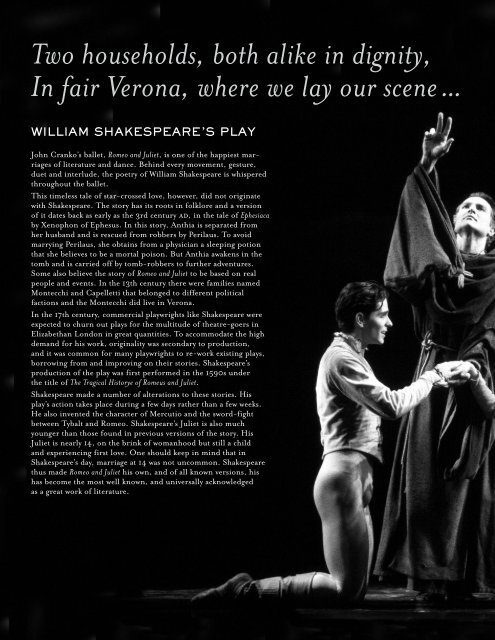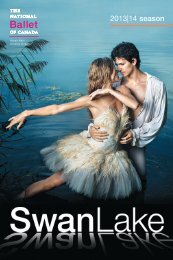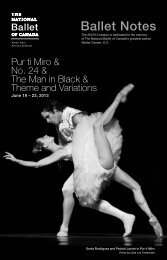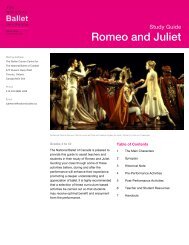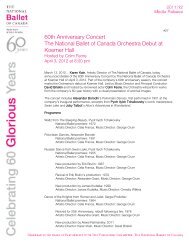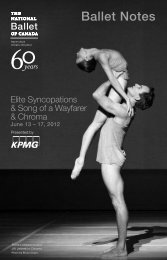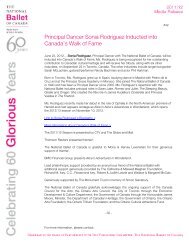ROMEO Notes - The National Ballet of Canada
ROMEO Notes - The National Ballet of Canada
ROMEO Notes - The National Ballet of Canada
You also want an ePaper? Increase the reach of your titles
YUMPU automatically turns print PDFs into web optimized ePapers that Google loves.
Two households, both alike in dignity,<br />
In fair Verona, where we lay our scene ...<br />
WILLIAM SHAKESPEARE’S PLAY<br />
John Cranko’s ballet, Romeo and Juliet, is one <strong>of</strong> the happiest marriages<br />
<strong>of</strong> literature and dance. Behind every movement, gesture,<br />
duet and interlude, the poetry <strong>of</strong> William Shakespeare is whispered<br />
throughout the ballet.<br />
This timeless tale <strong>of</strong> star-crossed love, however, did not originate<br />
with Shakespeare. <strong>The</strong> story has its roots in folklore and a version<br />
<strong>of</strong> it dates back as early as the 3rd century AD, in the tale <strong>of</strong> Ephesiaca<br />
by Xenophon <strong>of</strong> Ephesus. In this story, Anthia is separated from<br />
her husband and is rescued from robbers by Perilaus. To avoid<br />
marrying Perilaus, she obtains from a physician a sleeping potion<br />
that she believes to be a mortal poison. But Anthia awakens in the<br />
tomb and is carried <strong>of</strong>f by tomb-robbers to further adventures.<br />
Some also believe the story <strong>of</strong> Romeo and Juliet to be based on real<br />
people and events. In the 13th century there were families named<br />
Montecchi and Capelletti that belonged to different political<br />
factions and the Montecchi did live in Verona.<br />
In the 17th century, commercial playwrights like Shakespeare were<br />
expected to churn out plays for the multitude <strong>of</strong> theatre-goers in<br />
Elizabethan London in great quantities. To accommodate the high<br />
demand for his work, originality was secondary to production,<br />
and it was common for many playwrights to re-work existing plays,<br />
borrowing from and improving on their stories. Shakespeare’s<br />
production <strong>of</strong> the play was first performed in the 1590s under<br />
the title <strong>of</strong> <strong>The</strong> Tragical Historye <strong>of</strong> Romeus and Juliet.<br />
Shakespeare made a number <strong>of</strong> alterations to these stories. His<br />
play’s action takes place during a few days rather than a few weeks.<br />
He also invented the character <strong>of</strong> Mercutio and the sword-fight<br />
between Tybalt and Romeo. Shakespeare’s Juliet is also much<br />
younger than those found in previous versions <strong>of</strong> the story. His<br />
Juliet is nearly 14, on the brink <strong>of</strong> womanhood but still a child<br />
and experiencing first love. One should keep in mind that in<br />
Shakespeare’s day, marriage at 14 was not uncommon. Shakespeare<br />
thus made Romeo and Juliet his own, and <strong>of</strong> all known versions, his<br />
has become the most well known, and universally acknowledged<br />
as a great work <strong>of</strong> literature.


